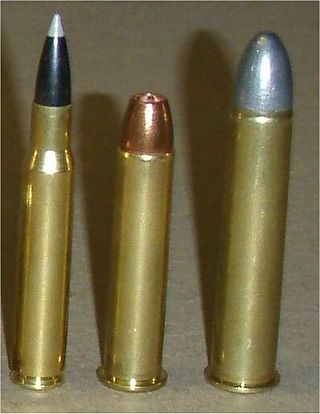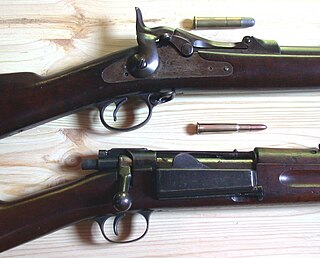Related Research Articles

The Krag–Jørgensen is a repeating bolt-action rifle designed by the Norwegians Ole Herman Johannes Krag and Erik Jørgensen in the late 19th century. It was adopted as a standard arm by Norway, Denmark, and the United States. About 300 were delivered to Boer forces of the South African Republic.

In firearm designs, the term single-shot refers to guns that can hold only a single round of ammunition inside and thus must be reloaded manually after every shot. Compared to multi-shot repeating firearms ("repeaters"), single-shot designs have no moving parts other than the trigger, hammer/firing pin or frizzen, and therefore do not need a sizable receiver behind the barrel to accommodate a moving action, making them far less complex and more robust than revolvers or magazine/belt-fed firearms, but also with much slower rates of fire.

The M1903 Springfield, officially the United States Rifle, Caliber .30-06, Model 1903, is an American five-round magazine-fed, bolt-action service repeating rifle, used primarily during the first half of the 20th century.
The term Springfield rifle may refer to any one of several types of small arms produced by the Springfield Armory in Springfield, Massachusetts, for the United States armed forces.

The .45-70, also known as the .45-70 Government, is a .45 caliber rifle cartridge originally holding 70 grains of black powder that was developed at the U.S. Army's Springfield Armory for use in the Springfield Model 1873. It was a replacement for the stop-gap .50-70 Government cartridge, which had been adopted in 1866, one year after the end of the American Civil War, and is known by collectors as the "Trapdoor Springfield."
The Springfield Model 1873 was the first standard-issue breech-loading rifle adopted by the United States Army. The gun, in both full-length and carbine versions, was widely used in subsequent battles against Native Americans.

The Springfield Model 1865 was an early breech-loading rifle manufactured by U.S. Armory in Springfield, Massachusetts. It was a modification of the Springfield Model 1861. It was later replaced with the Springfield Model 1866.

The Springfield Model 1870 was one of the rifles which used the trapdoor breechblock design developed by Erskine S. Allin. The Model 1870 was a minor improvement to the Springfield Model 1868, and retained most of the Model 1868 rifle features.

The Springfield Model 1868 was one of the rifles which used the trapdoor breechblock design developed by Erskine S. Allin.

The Springfield Model 1892–99 Krag–Jørgensen rifle is a Norwegian-designed bolt-action rifle that was adopted in 1892 as the standard United States Army military longarm, chambered for U.S. caliber .30-40 Krag cartridges. All versions and variants were manufactured under license by the Springfield Armory between 1892 and 1903 and famously served as the longarm during the Spanish–American War.
The Mauser Model 1893 is a bolt-action rifle commonly referred to as the Spanish Mauser, though the model was adopted by other countries in other calibers, most notably the Ottoman Empire. The M1893 was based on the experimental M1892 rifle, which Paul Mauser developed for the Spanish Army as part of a program to correct deficiencies in the earlier 1889, 1890, and 1891 series of Mauser rifles. The M1893 introduced a short staggered-column box magazine that fit flush with the bottom of the stock; the magazine held five smokeless 7×57mm Mauser rounds, which could be reloaded quickly by pushing a stripper clip from the top of the open bolt.
The Winchester Hotchkiss was a bolt-action repeating rifle patented by Benjamin B. Hotchkiss in 1876 and produced by the Winchester Repeating Arms Company and Springfield Armory from 1878. The Hotchkiss, like most early bolt-actions, had a single rear locking lug integral with the bolt handle, but was unique in feeding multiple rounds from a tubular buttstock magazine similar to the Spencer rifle. The .45-70 Hotchkiss was acquired in limited numbers by the US Navy as the M1879, and by the US Army and several state militias as the M1883, making it the first center-fire bolt-action repeater to be adopted by any major military.
The Springfield Model 1869 was one of several model "trapdoor Springfields", which used the trapdoor breechblock design developed by Erskine S. Allin.
The Springfield Model 1880 was a trapdoor rifle based on the design of the Springfield Model 1873.
The Springfield Model 1882 Short Rifle was a trapdoor rifle based on the design of the Springfield Model 1873. It is usually referred to as a "short rifle" but is sometimes called a "carbine".
The Springfield model 1884 was one of the "Trapdoor Springfield" rifles. It was an improved replacement for the previous longarm of the U.S. Armed Forces, the Springfield model 1873.

The Mauser Model 1889 is a bolt-action rifle of Belgian origin. It became known as the 1889 Belgian Mauser, 1891 Argentine Mauser, and 1890 Turkish Mauser.
The term Joslyn Rifle refers to a series of rifles produced in the mid-19th century. The term is often used to refer specifically to the Joslyn Model 1861/1862, which was the first mass-produced breech-loading rifle produced at the Springfield Armory.
The Springfield Model 1855 was a rifled musket widely used in the American Civil War. It exploited the advantages of the new conical Minié ball, which could be deadly at over 1,000 yards (910 m). It was a standard infantry weapon for Union and Confederates alike, until the Springfield Model 1861 supplanted it, obviating the use of the insufficiently weather resistant Maynard tape primer.

In firearms, a trapdoor is a form of breech-loading mechanism for rifles in which a hinged breechblock rotates up and forward, resembling the movement of a trapdoor. The Springfield models 1865 and 1873 were best known for first employing this type of action.